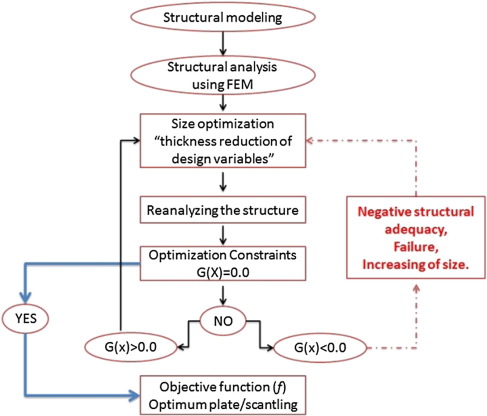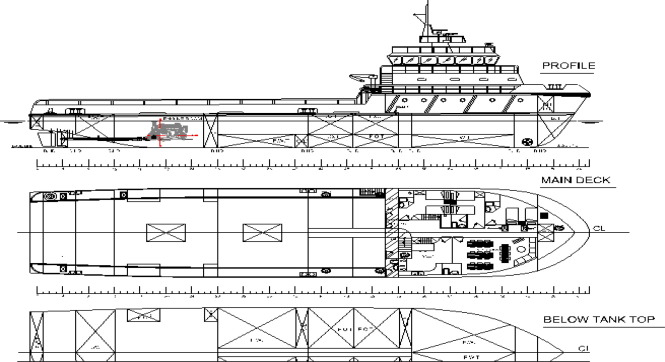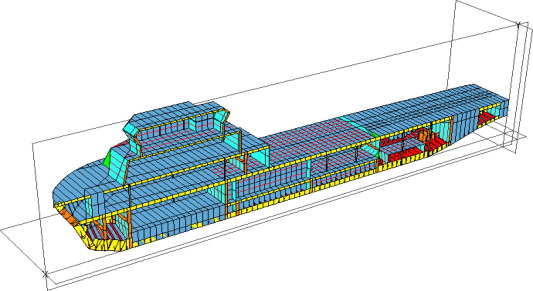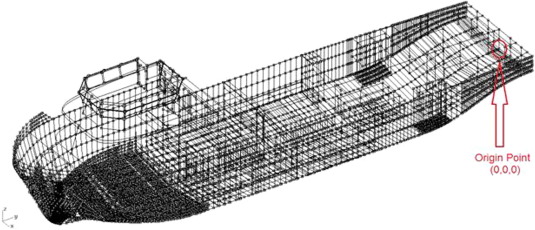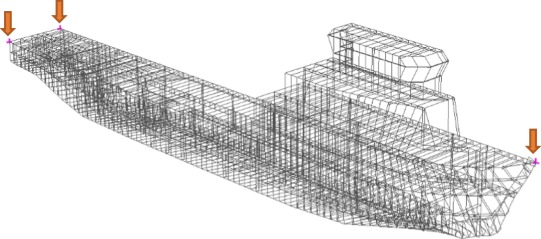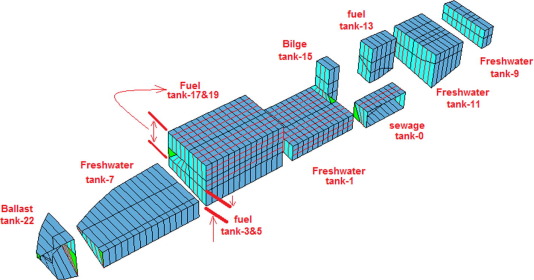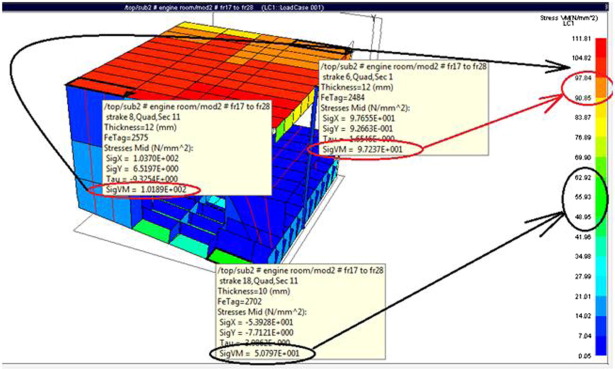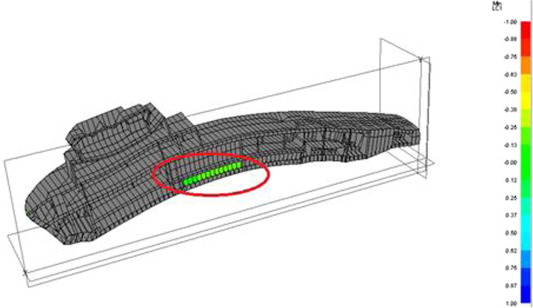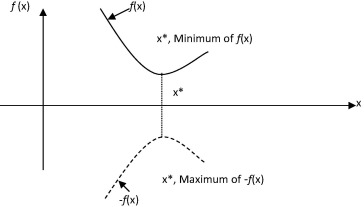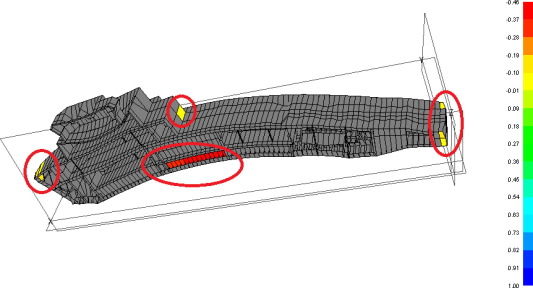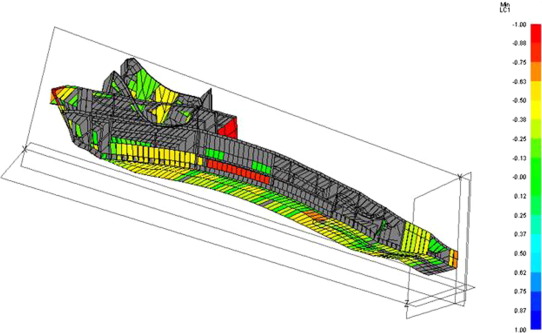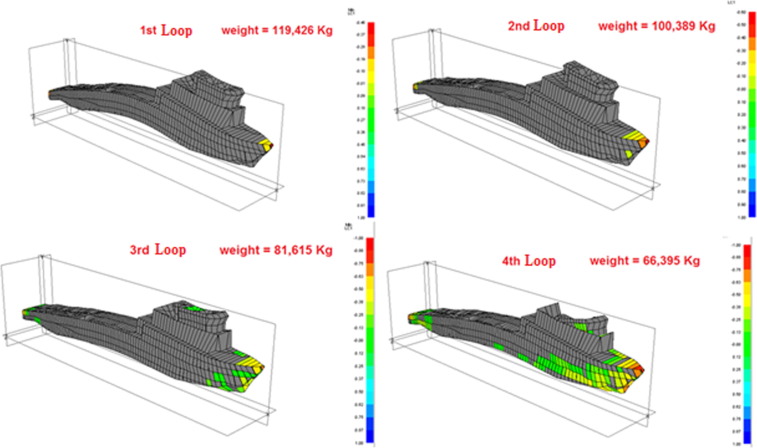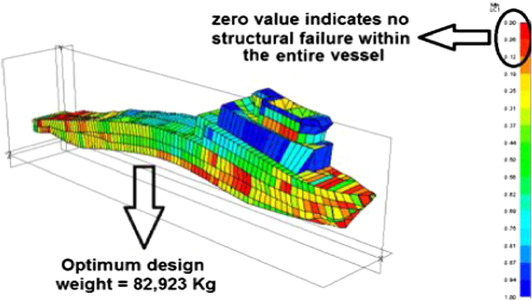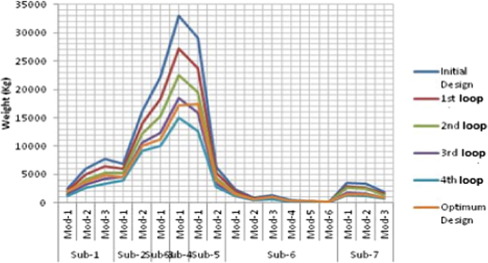Abstract
Ship design process usually relies on statistics and comparisons with existing ships, rather than analytical approaches and optimization techniques. Designers found this way as the best to fulfil the owner’s requirements, but better solutions, for both the shipyard and the owner may exist. Assessing ship life cycle cost is one of the most attractive tasks for shipyard during early design stage. Structural optimization can be used to achieve that task. In this paper, a comprehensive study on the structural optimization of an offshore supply vessel (OSV), as a case study, is presented. Detailed structural modeling of the vessel is created. Various environmental loads acting on the ship hull such as still water loads and wave induced loads are briefly explained. Different loading conditions and corresponding structural responses have been investigated to assign the most severe one on the vessel. The basic concept of structural optimization and optimization characteristics is highlighted. Blind search optimization technique is applied and approximately forty-two percent weight and cost savings are found by comparing the weight of various design scenarios together without showing any structural inadequacy.
Keywords
Offshore supply vessel OSV; Structural modeling; Finite element analysis; Search optimization
1. Introduction
At the preliminary design stage, shipyards need to assess the construction cost, to compare fabrication sequences and to find the best frame/stiffener spacing and most suitable scantlings to minimize the life cycle cost of the ship. This can be achieved by performing structural optimization. Structural optimization deals with the application of mathematical optimization to the computer aided optimum design of structures. The task of the mathematical optimization process was to find the optimum point, from any starting point, and to do so with as little computation as possible [1]. A certain number of design variables (e.g. thickness, shape or cross-sectional area of a structure) have to be determined in a way that the objective function (e.g. minimal weight of a construction) is best fulfilled in compliance with the state variables (e.g. strength, stiffness or production). Depending on the design variables, structural optimization can be classified as follows [2]:
- Shape optimization
- Topological optimization
- Choice of material
- Scantling optimization
Ship’s main dimensions determine many of her characteristics, e.g. stability, hold capacity, power requirements, and more importantly her economic efficiency. Therefore determining the main dimensions and ratios, as well as coordinating them in such a way that a ship satisfies the design conditions forms a particularly important phase in the overall design. The characteristics desired by a shipping company can be usually achieved through various combinations of dimensions. Such characteristics could have allowed for an economic optimum design to be achieved if it were not for the restrictions imposed by size of locks, canals, slip waterways and bridges and most commonly water depth. Thus, in the marine market, fleet optimization objective is often to find the optimum number of ships, ship speed and capacity without going into further details of her main dimensions. A ship’s economic efficiency is usually improved by increasing her size, and accordingly this could lead to the specific cost decreases. In general, the larger the ship, the more economically efficient she is [3].
According to the above-mentioned aspects a perfect ship does not typically exist; however, weight reduction for a well-known design achieving its purpose without shape (main dimensions) alteration leads to a less fuel consumption, increased deadweight, more freeboard, less initial cost, more speed and even better accessibility to channels and harbors with lesser depths. Therefore, the structural weight optimization of an OSV using the size optimization method is introduced in this paper. The procedure employed in this paper consists of four main steps. OSV structural modeling is considered as the most important step. It is the base for all following steps. Next step is to define nodes and elements for each member of the OSV model in addition to assigning loads and boundary conditions in order to apply finite element method. Verification of the obtained response must be considered to assure that there are no structure inadequacies of the model. The final step is to apply the size optimization technique to achieve the optimum weight of the vessel. All steps are outlined as shown in Fig. 1.
|
|
|
Figure 1. Procedures of vessel size optimization. |
2. OSV description
The main function of the OSV(s) is to transport stores materials, equipment and/or personnel (excluding crew boats) to, from and between offshore installations. The Class notation of the investigated existing vessel is Bureau Veritas and the vessel is intended to operate in the red sea. It is worth mentioning that this vessel is selected as a case study because this type of vessels represents the highest percentage of the vessels building and operating in the area of Gulf of Suez. The vessel main characteristics and capacities are mentioned below in Table 1. Fig. 2 shows an outline of the ship’s general arrangement.
| Capacities | Characteristics | ||
|---|---|---|---|
| Deck cargo | 200 tons | Length, overall | 44 m |
| Fresh water | 200 tons | Beam | 10 m |
| Fuel oil | 200 tons | Depth | 3.92 m |
| Cooler/freezer | 6 Cubic meter | Displacements | 950 tons |
| Passengers | 19 Persons | Dead weight | 610 tons |
| Crew | 10 Persons | Max draft | 3.1 m |
| Passengers | Crew | Light draft | 1.45 m |
| Frame spacing | 0.500 m | ||
| – 1 Single rooms | – 2 Single rooms | Bollard pull | 25 Ton |
| – 3 Double rooms | – 1 Double rooms | ||
| – 3 Rooms × 4 beds | – 1 Room × 6 beds | ||
| Class | BV | ||
| Speed/fuel consumption | |||
| Cruising speed | 12 Knots; 116 l/h | ||
| Max speed | 13.5 Knots; 155 l/h | ||
|
|
|
Figure 2. Vessel general arrangement. |
3. OSV environmental loads
3.1. Still water loads
When a ship is at sea, she is subjected to forces which cause the structure to deflect. The correct assessment of the magnitude of the forces is difficult. The forces may be divided into static and dynamic components. Still water forces are static in nature as the ship is considered to be floating in equilibrium. Still water load curve is obtained as the algebraic sum of weight and buoyancy curves. Different loading conditions are assigned to the ship in order to determine the worst one. Table 2 summarizes these loading conditions. In order to determine the distribution of bending moment along the ship, the weight and buoyancy, load, shear and moment distributions for the worst loading condition are obtained.
| Loading condition | Description |
|---|---|
| Lightship condition | The ship has no personnel, consumables or cargo on board but it has its special outfitting |
| Transit condition | The vessel has only the ship’s crew on board and has one hundred percent of its fresh water. There is no cargo or variable deck loads on board but the vessel is full of lube oil and has fifty percent of its fuel and provisions |
| Departure to offshore platform | The ship has the ship‘s crew on board. She is carrying one hundred percent of its provisions, water, fuel and lube oil. The ship is carrying all of the variable deck loads including cargo and deadweights |
| Departure from oil field condition | The ship is carrying one hundred percent of its water and lube oil while it is carrying thirty-five percent of its fuel and provisions |
| Arrival at port condition | The ship is carrying one hundred percent of its water and lube oil while it is carrying ten percent of its fuel and provisions |
3.2. Wave-induced loads
Wave induced loads are usually known as slowly varying loads, which consist of the dynamic pressure distribution on the hull due to the combination of wave encounter and the resulting ship motion, sloshing of liquid cargo, shipping of green seas on deck, wave slap on sides and on foredecks, inertia loads, launching and berthing loads, and ice breaking loads.
4. OSV structural modeling
OSV structural modeling is carried out using MAESTRO software version 9.1. MAESTRO is Method for Analysis Evaluation and Structural Optimization. The MAESTRO Design System has four main capabilities: overall or global stress analysis, structural adequacy (limit-state) evaluation, structural design optimization, and fine mesh (local) stress analysis. The objective of any structural finite element analysis was to accurately determine the response of a structural system that is modeled with finite elements and subjected to given loads. MAESTRO accomplishes this objective through a single Windows-based graphical user interface that completely encompasses the structural modeling (pre-processing), the ship-based loading, the finite element analysis, the limit-state evaluation, and the post-processing. The theoretical basis for MAESTRO is provided in Ref. [1]. Using such program requires a good understating of the inputs and the inside processing in order to evaluate the output results. Successful creation of the ship model can lead to a good expectation of the final results. The basic unit of structural modeling is a principal member such as a transverse frame (red beam), stiffened panel (dark blue), girder (yellow beam), and rod (brown line), and the entire structural model is represented below in Fig. 3. The finite element types most commonly used in MAESTRO are as follows:
- CQuadR Stiffened Panel: CQuadR is a 4 nodded flat shell element with each node having 6 degrees of freedom. It is the default element for all panels (strakes and quads).
- Hybrid CBAR Beam Element: This element has been used for modeling of beams (frames, girders, additional beams) attached to plating.
- CTRIR Triangle Element: This is a flat, constant strain element that can be placed between any three nodes.
- CRod Element: The rod element is a pin-jointed bar which can connect with any two nodes in a module.
|
|
|
Figure 3. Entire structural model of the vessel. |
In order to obtain the OSV structural response using finite element method under the subjected loads a fully structural detailed model is created. The OSV model consists of nodes and finite elements. The mesh is created by introducing reference points (nodes). These reference points are created manually by specifying their global coordinates. Fig. 4 shows the nodes representing the vessel main boundaries.
|
|
|
Figure 4. Nodes representing the vessel’s main boundaries. |
5. OSV structural analysis using a finite element method
5.1. Loading of the vessel
The constraints must be defined before loading the model in order to restrict the model’s movement in any of the 3 translational or 3 rotational degrees of freedom. Fig. 5 shows the vessel’s boundary conditions.
|
|
|
Figure 5. Vessel’s boundary conditions. |
5.2. Loading groups
All the weights on-board the vessel are assigned to groups within the structural hull. The largest weights on-board the vessels are those arising from the freshwater and fuel inside the tanks.
5.3. Volume group
Tanks are created by defining a volume group where the elements forming the boundary faces of the tank are selected as shown in Fig. 6 and the tanks’ weights and volumes are listed in Table 3.
|
|
|
Figure 6. Boundaries forming the vessel tanks. |
| Volume group name | Centreline | Volume (mm3) | Weight (kg) | XCG (mm) | YCG (mm) | ZCG (mm) | |
|---|---|---|---|---|---|---|---|
| 1 | FW tank-9 | No | 3.35E+09 | 3347.94 | 508.306 | 2975.02 | 334835 |
| 2 | FW tank-11 | No | 1.65676e+010 | 16567.5 | 5104.58 | 2558.1 | 3369.78 |
| 3 | FO tank-13 | No | 1.14605e+010 | 9626.79 | 8740.5 | 2187.17 | 4053.2 |
| 4 | Bilge tank-15 | No | 4.96E+09 | 5081.92 | 14001.4 | 2213.25 | 4237.21 |
| 5 | Sewage tank-0 | Yes | 7.79078e+009 | 7985.55 | 11504.5 | 959.748 | 0 |
| 6 | FW tank-1 | No | 3.03783e+010 | 30378.3 | 17552 | 926.828 | 2589.01 |
| 7 | Fuel tank- 3 + 5 | No | 3.57E+10 | 29970.3 | 24986 | 920.337 | 2550.95 |
| 8 | Fuel tank 17 + 19 | No | 3.41486e+010 | 28684.2 | 25007.7 | 2719.61 | 4625 |
| 9 | FW tank-7 | No | 3.71519e+010 | 37151.9 | 33028.2 | 932.462 | 1946.78 |
| 10 | Ballast tank-22 | Yes | 7.75791e+009 | 7951.25 | 40287.5 | 2931.25 | 0 |
| 11 | Total | 1.21E+11 | 176745.65 | 219535 | 1606.9 | 275925 |
Where: XCG longitudinal center of gravity.
YCG transverse center of gravity.
ZCG vertical center of gravity.
Similarly all loads within the vessel are assigned to their relevant groups in which only one load case is dealt with which represents the maximum (full) loading condition of the vessel. The other on-board loads are listed below:
- Deck cargo of 200 tons on-board the deck.
- A crane of 2 tons on upper deck between frames 42 and 46.
- Main engine and generator set of 6 tons allocated in the engine room.
- Anchor and windlass of 1 ton allocated in the bow.
- 15 tons of piping systems, deckhouse equipment, navigation equipment and store stuff each allocated in its relevant compartment.
5.4. OSV response results
Stress results: Von Mises stress results are plotted for several panels in the engine room area as shown in Fig. 7.
|
|
|
Figure 7. Von Mises stress plotted for several panels. |
Structural adequacy: All the structural inadequacies (failure) are highlighted in Fig. 8. For all structural members’ relevant failure modes the structural inadequacies are investigated, and the unsafe members (members with negative structural adequacy) are colored while other gray elements are those found to be safe.
|
|
|
Figure 8. Colored unsafe members. |
6. Structural optimization
Optimization is the act of obtaining the best result under given circumstances including constraints. In design, construction, and maintenance of any engineering system, many technological and managerial decisions have to be taken at several stages. The ultimate goal of all such decisions was to either minimize the effort required or maximize the desired benefit. Since the effort required or the benefit desired in any practical situation can be expressed as a function of certain decision variables, optimization can be defined as the process of finding the conditions that give the maximum or minimum value of a function. It can be seen from Fig. 9 that if a point x∗ corresponds to the minimum value of function f(x), the same point also corresponds to the maximum value of the negative of the function −f(x). There is no single method available for solving all optimization problems efficiently. Design optimization of any system can be considered as a combination of design and analysis of the system [4]. Designing a system is the process of producing a new design. Analysis is the process of determining the effectiveness of this particular design. While designing a system, a set of conditions called constraints are to be satisfied.
|
|
|
Figure 9. Minimum of f(x) is the same as maximum of −f(x). |
There are many approaches to optimization. One approach is searching, and another is mathematical optimization.
Searching is an approach in which all of the possible solutions or a few solutions have been tried to infer from them the more appropriate solutions. The objective function must be evaluated a large number of times. In doing so, a fixed combination of all possible values for design variables within a range of maximum and minimum limits must be generated and by using a continuous loop all possible output values are calculated [5]. The minimum value for the objective functions will result in saving the corresponding input design variables. This kind of search is called “blind search” within all possible values in the input space. This method requires a large number of loops which may sometimes last for long time depending on the number of input design variables as well as the step interval between the maximum and minimum value of each input design variable. To reduce the number of loops in OSV optimization the existing design values are selected to be the initial values and a constant reduction in the plate thickness and stiffener scantlings is implemented to reach the minimum values.
6.1. OSV structural optimization characteristics
Optimization is in general characterized by three elements:
- A set of “n ” design variables to be altered
Design variable (X): is an n-dimensional vector called the design vector, and which can be changed during optimization. It may represent geometry or choice of material. All the structural members are the design variables of the vessel [6].
- A set of functions to be optimized, (x), (x), … (x), which are the objective function(s),
Objective function (f): A function is used to classify designs. For every possible design, f returns a number which indicates the goodness of the design. Usually we choose f such that a small value is better than a large one (a minimization problem). Frequently f measures weight, displacement in a given direction, effective stress or even cost of production. The objective function is the minimization of the vessel structural weight to the bare minimum satisfying her structural adequacy.
- A set of constraints to be satisfied, (x), (x), … (x)
Constraint (g): For a given structure, (x) is a function that represents a constraint on the optimization process; otherwise, it is a problem without a well-defined solution. A constraint on an optimization process could be the response of the structure and it is a specific value decided by the analyst [7].
For all structural members’ relevant failure modes in each load case of the vessel, the actual stresses are compared with the failure stresses, and for every one of these combinations an “adequacy parameter” is generated. An adequacy parameter is a number between −1 and +1. A negative value means that for that failure mode and load case, the member has failed, or at least that the safety margin is less than what was specified. A “Zero” means that the member has exactly the required safety margin and no more; thus, a “Zero” value is the minimum acceptable value for any structural member. A positive value means that the safety margin is larger than the specified value [8]. The constraints on the vessel optimization are the structural adequacies of all the failure modes listed below. The structural adequacy value of any failure mode under any loading condition is not to be of negative value by any means.
6.2. OSV scantling optimization
In scantling optimization, or optimization of discrete parameter systems as it is often called, the scantlings of the already defined structural members are reduced to find the optimal design. During the scantling optimization, the vessel configuration remains constant in which no elements are added or removed [9]. All the structural members listed below in Table 4 are to be minimized to the bare minimum satisfying their safety margin in order to minimize the total structural weight. In order to achieve that all the structural members are to be reduced gradually while investigating the structural response, the 1st loop structural member’s (plates and beams) scantlings are listed in Table 5 and Table 6.
|
|
| Plate | Thickness (mm) |
|---|---|
| Outer shell | 10 |
| (Fr-1 to Fr1) plate | 7 |
| Deck | 12 |
| Bulkheads | 8 |
| Deckhouse | 5 |
| Stiffener type | Sec type | Material | Web height | Web Thk | Flange width | Flange Thk |
|---|---|---|---|---|---|---|
| Web frame (250 ∗ 10 + 150 ∗ 16) | Tee | ST24 | 250 | 10 | 150 | 16 |
| L (100 ∗ 100 ∗ 10) | Angle | ST24 | 100 | 10 | 100 | 10 |
| T 350 ∗ 12 + 220 ∗ 16 | Tee | ST24 | 350 | 12 | 220 | 16 |
| T-section (100 ∗ 8) | Bar | ST24 | 100 | 8 | 100 | 8 |
| ER (T 500 ∗ 10 + 150 ∗ 16) | Tee | ST24 | 500 | 10 | 150 | 16 |
| ER (T 680 ∗ 10 + 150 ∗ 16) | Tee | ST24 | 680 | 10 | 150 | 16 |
| ER (T 796∗10 + 150∗16) | Tee | ST24 | 796 | 10 | 150 | 16 |
| ER (T 895 ∗ 10 + 150 ∗ 16) | Tee | ST24 | 895 | 10 | 150 | 16 |
| Engine found (L-380) | Angle | ST24 | 380 | 20 | 330 | 25 |
| Engine found (L-500) | Angle | ST24 | 500 | 20 | 330 | 25 |
| ER (T 700 ∗ 10 + 150 ∗ 16) | Tee | ST24 | 700 | 10 | 150 | 16 |
| ER (T 600 ∗ 10 + 150 ∗ 16) | Tee | ST24 | 600 | 10 | 150 | 16 |
| ER (T 80 ∗ 20 + 150 ∗ 25) | Tee | ST24 | 80 | 20 | 150 | 25 |
| T 250 ∗ 10 + 220 ∗ 16 | Tee | ST24 | 250 | 10 | 220 | 16 |
| Raised main deck (T 250 ∗ 10 + 150 ∗ 14) | Tee | ST24 | 250 | 10 | 150 | 14 |
| Sub5 (T1000 ∗ 10 + 150 ∗ 16) | Tee | ST24 | 1000 | 10 | 150 | 16 |
| Sub6 (T500 ∗ 12 + 150 ∗ 16) | Tee | ST24 | 500 | 12 | 150 | 16 |
| SS (L60 ∗ 60 ∗ 6) | Angle | ST24 | 60 | 6 | 60 | 6 |
| SS (T 150 ∗ 10 + 100 ∗ 10) | Tee | ST24 | 150 | 10 | 100 | 10 |
| Flat bar (50 ∗ 30) | Tee | ST24 | 50 | 30 | – | – |
| Initial PLATE thickness (mm) | New plate thickness (mm) |
|---|---|
| 10 | 9 |
| 7 | 6 |
| 12 | 11 |
| 8 | 7 |
| 6 | 5 |
| Initial beam dimensions | New beam dimensions |
|---|---|
| T (350 ∗ 10 + 150 ∗ 16) | T (330 ∗ 8 + 130 ∗ 14) |
| T (250 ∗ 10 + 150 ∗ 16) | T (230 ∗ 8 + 130 ∗ 14) |
| L (100 ∗ 100 ∗ 10) | L (80 ∗ 80 ∗ 8) |
| T (350 ∗ 12 + 220 ∗ 16) | T (330 ∗ 10 + 200 ∗ 14) |
| T (250 ∗ 10 + 220 ∗ 16) | T (230 ∗ 8 + 200 ∗ 14) |
| T (250 ∗ 10 + 150 ∗ 14) | T (230 ∗ 8 + 130 ∗ 12) |
6.3. OSV structural response
The structural analysis of the 1st loop leads to a considerable loss in the structural safety as shown in Fig. 10. The structural reduction goes on similarly for the 2nd, 3rd and 4th loops. In the 4th loop all the steel plate thicknesses and stiffener dimensions are reduced as mentioned below in Table 7 and Table 8. The structural analysis of the 4th loop shows a severe structural failure as shown in Fig. 11. The weights and structural adequacy of the four loops are shown in Fig. 12.
|
|
|
Figure 10. 1st Loop structural inadequacy. |
| Initial plate thickness (mm) | New plate thickness (mm) |
|---|---|
| 10 | 6 |
| 7 | 3 |
| 12 | 8 |
| 8 | 4 |
| 6 | 2 |
| Initial beam dimensions | New beam dimensions |
|---|---|
| T (350 ∗ 10 + 150 ∗ 16) | T (270 ∗ 3 + 70 ∗ 8) |
| T (250 ∗ 10 + 150 ∗ 16) | T (170 ∗ 3 + 70 ∗ 8) |
| L (100 ∗ 100 ∗ 10) | L (50 ∗ 50 ∗ 5) |
| T (350 ∗ 12 + 220 ∗ 16) | T (270 ∗ 4 + 140 ∗ 8) |
| T (250 ∗ 10 + 220 ∗ 16) | T (170 ∗ 3 + 140 ∗ 8) |
| T (250 ∗ 10 + 150 ∗ 14) | T (170 ∗ 3 + 70 ∗ 6) |
| L (60 ∗ 60 ∗ 6) | L (20 ∗ 20 ∗ 2) |
| T (150 ∗ 10 + 100 ∗ 10) | T (70 ∗ 3 + 30 ∗ 3) |
| Bar (100 ∗ 8) | Bar (70 ∗ 5) |
| T (1000 ∗ 10)+(150 ∗ 16) | T (500 ∗ 5)+(90 ∗ 10) |
|
|
|
Figure 11. 4th Loop structural inadequacy. |
|
|
|
Figure 12. Weights and structural response of the four loops. |
6.4. Determination of objective function
Since modifying all the plates’ thicknesses and beam dimensions is applied to all the substructures and modules of the model, a module is found to be failing to satisfy its safety margin while other is found to be over stiffened. This is proved previously in the first to fourth loop. For instance, the fourth loop illustrates how each module contains elements withstanding the stresses imposed to them and others failing to maintain their structural adequacy.
Thus, the best method to optimize the model is to study each module separately and reduce the structural elements’ thicknesses and modulus of each strake to the bare minimum safe value. This results in a structure satisfying its safety margin and maintaining its structural adequacy with a minimum weight as shown in Fig. 13.
|
|
|
Figure 13. Optimum design weight and structural response. |
6.5. Optimization results
The structural optimization of the offshore supply vessel led to a 42% saving in the vessel structural weight and steel price without showing any structural failure in the vessel. The estimated steel weights of all loops are shown in below graph in Fig. 14 and Table 9.
|
|
|
Figure 14. Different loops modules weight in kg. |
| Weight of substructures and modules | |||||||||||
|---|---|---|---|---|---|---|---|---|---|---|---|
| Initial design | 1st Loop | % Reduction | 2nd loop | % Reduction | 3rd Loop | % Reduction | 4th Loop | % Reduction | Optimum design | % Reduction | |
| Model steel weight (ton) | 143.88 | 119.43 | 16.99 | 100.39 | 30.22 | 81.62 | 43.27 | 66.40 | 53.85 | 82.92 | 42.36 |
| Total steel ship weight (ton) | 287.75 | 238.85 | 16.99 | 200.78 | 30.22 | 163.23 | 43.27 | 132.79 | 53.85 | 165.85 | 42.36 |
7. Conclusions
From the presented work the following main points could be included:
- The structural optimization of an offshore supply vessel OSV is investigated. A detailed finite element model of the vessel is created using MAESTRO program in order to assign all the loads and obtaining accurate structural response.
- Blind search optimization technique is applied with constant reduction in scantlings from the initial design to the minimum values. Four loops are applied to the vessel with observing their structural adequacy and corresponding responses. The fourth loop shows the severe failure of the structural members.
- The size structural optimization of the vessel managed to reduce 121.9 tons of her steel weight which led to a 42.4% saving of the total steel weight and price without showing any structural inadequacy by reducing structural element thickness and modulus of each strake to the bare minimum safe value. This weight reduction for a specific well-known design without altering its main dimensions offers best possible alternative for the sake of economic efficiency as it offers less fuel consumption, a lower initial cost, a better accessibility to harbors and canals, and even a higher service speed in the lightship condition.
References
- [1] O.F. Hughes, J.K. Paik; Ship Structural Design, A Rationally-m Based Computer-Aided Optimization Approach; The Society of Naval Architects and Marine Engineers (2010)
- [2] Z. Sekulski; Structural weight minimization of high speed vehicle-passenger catamaran by genetic algorithm; Pol. Marit. Res., 16 (2) (2009), pp. 11–23 (60)
- [3] H. Schneekluth, V. Bertram; Ship Design for Efficiency and Economy; British Library Cataloguing in Publication Data (1998)
- [4] N. Vanderplaats Garrett; Numerical Optimization Techniques for Engineering Design; McGraw Hill, N.Y. (1984)
- [5] D.B. Dansman, E. Mesbahi, M. Atlar, Ö. Gőren, A new form optimization technique for minimum wave resistance, in: 10th Int. Maritime of the Mediterranean Congress, I.M.A.M, Crete, Greece, 2002.
- [6] N.G.R. Iyengar; Optimization in Structural Design; Jain University, India (2004)
- [7] Toklu Y. Cengiz; Optimization in Structural Analysis and Design; Structures 2009 Congress, Austin, Texas, USA (2009)
- [8] K.J. Bathe; Finite Element Procedures in Engineering Analysis; Prentice-Hall Inc., Englewood Cliffs, New Jersey (1982)
- [9] W. Christensen Peter, A. Klarbring; An Introduction to Structural Optimization; Springer (2008)
Document information
Published on 12/04/17
Licence: Other
Share this document
Keywords
claim authorship
Are you one of the authors of this document?
